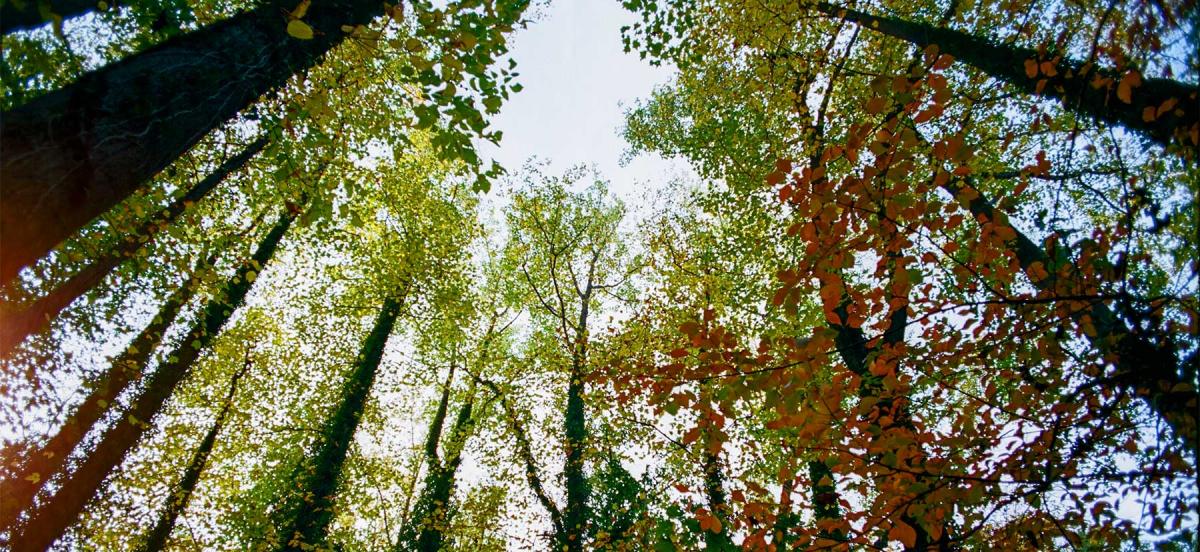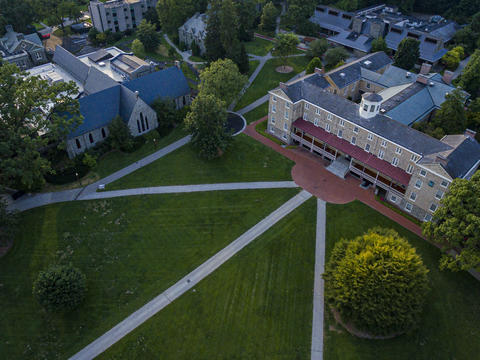Haverford College Begins Arboretum Revitalization

Photo by Rae Yuan '19
Details
Following the College's first-ever comprehensive tree assessment, a massive renewal project aimed at preserving Haverford's beloved natural resources for generations to come and keeping the campus community safe is taking shape.
Haverford College's arboretum—encompassing the campus' 400 species of trees and shrubs, a 3.5-acre Duck Pond, gardens, and wooded areas—has been a part of the College's history almost since its inception. English gardener William Carvill arrived on campus in 1834, a year after Haverford's first students, creating what would become the oldest planned college landscape in America. Care for this beloved landscape was always part of the College's mission, even if it took a devastating 1902 ice storm that almost destroyed the maple allée on College Lane to formally create a campus club (a nascent version of what is now known as the Haverford College Arboretum Association) dedicated to its preservation.
The latest chapter in the arboretum's history began last year with its first-ever comprehensive tree assessment, conducted by Rockwell Associates, which identified a number of risks to the safety of the campus community and threats to the long-term health of the College's arboreal landscape, including invasive species and a significant number of trees in deteriorating condition. Remedial steps include the pruning of 408 trees from inner campus and the Nature Trail and the removal of 406 defective, decaying, or otherwise failing ones.
"It is important to take care of our campus ecosystems," says Chief Sustainability Officer and Presidential Chief of Staff Jesse Lytle. "One of the responsibilities of being a perpetual institution is that you have to think not just about the current generation, but of future generations too. That is something that we took seriously in the Plan for 2020 as we thought about multiple dimensions of the College that sustain us, whether it's our finances or our natural resources. It’s not just about delivering on our mission now, but also making sure we are able to deliver on our mission for many generations to come."
For a place that defines itself in many ways by its physical landscape, the numbers involved in the tree revitalization can be hard to hear, but for every tree removed, two will be planted. As a result, Haverford will be more than 800 trees richer when this project is completed, and a safer place after trees that are sick or in danger of falling during a weather event have been cleared.
"People grow very attached to trees, and the arboretum staff is no exception," says Arboretum Director Claudia Kent. "We’ve planted hundreds on Haverford’s campus over the last few decades. We’ve taken care of them, we’ve pruned them, and we’ve fought for them during construction projects. We consider them friends. Like any friend, we mourn the loss when it’s determined they need to come down. For this reason, we felt we needed to hire an outside consultant for the assessment. He has no emotional attachment to our collection and was able to be impartial concerning its overall health."
"Trees that are declining, considered a risk, or that have pre-existing defects are removed to ensure the safety standards are being met," says John Rockwell Hosbach Jr., the urban forester who conducted the assessment. "This, in turn, allows the College to replant with a diverse palate of trees, implement new best management practices, and to ensure that the health of the College’s urban forest is better prepared for the future."
There are sustainability issues to consider as well. Due to climate change, land-based plant and animal species are moving poleward at a rate of 15 feet per day. That means that 100 years from now some of the core species of trees found on campus, such as sugar maples, may no longer thrive in southeastern Pennsylvania. Lytle, the chief sustainability officer, says that this massive replanting project provides an opportunity to ensure that the College chooses specimens more apt to thrive in the changing ecosystem.
"We are in the position of being able to think ahead about how to maintain Haverford's sense of place while understanding the realities of our changing environment," he says. "The campus has looked different over different periods of its history. This will be a period when there is more new tree growth, and that may be an adjustment right now, but it is in service of having a campus that will still feel like Haverford into the future."
None of this will happen overnight. The work on the Nature Trail has begun and will continue during winter months over the next three years. Pruning at the center of campus will be completed over a five-year period. And replanting efforts, which should take five to ten years, are already underway. Eighty new trees were planted along the streambank in the fall during events that were open to the public, and more volunteer tree plantings are in store for the spring, including a weeklong plant-a-tree-a-day marathon leading up to Arbor Day on April 27. A new plant nursery is also being installed, and students from nearby Friends School Haverford will nurture its whips and small trees over the next few years for eventual planting on our campus.
This revitalization project, however, is more than just removing sick trees and replanting with young ones. Vehicles and thousands of footsteps have compacted soils on campus, so a process called "air spading" of root zones will help relieve compaction while expanding the mulched area around trees will protect shallow roots from feet and mower damage.
All of this work in service of protecting Haverford's historic trees—and then expanding the existing tree canopy—is important not only for the enjoyment of the Haverford community and its many visitors, but for the health of the larger ecosystem.
"Standing on Lancaster Ave., you’d never believe we live in the Eastern Deciduous Forest," says Kent. "Due to agriculture, timber, and urban expansion our Eastern Deciduous Forest has become very fragmented. From a wildlife perspective, [animals] need large areas of green space to be able to survive. It's important that we expand and connect our greenspace with other greenspaces in the area."
"Being a perpetual institution takes discipline and foresight," says Lytle. "Because of this revitalization effort, we'll have a more vibrant campus with a more robust, healthy tree canopy in the future. Haverford’s identity is intertwined with our natural beauty, and perpetuating that is something that has to happen intentionally. This is a critical step in that direction."



